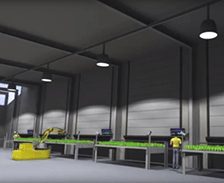Commercial indoor agriculture in the UK is largely based in England and Wales with vertical farming being focused on in London. A situation that changes this fall with the launch of Scotland’s first vertical farm. There are no ZipGrow Towers here. This growing rack system could change everything. Not just in the UK, but globally.
 The UK’s “first commercially viable” vertical farming system installation at the James Hutton Institute, a world-renown plant science facility near Dundee, is in the final stages of completion. Upon launch, the full-scale trial grow will commence. No overnight wonder, they’ve been working on this vertical hydroponic farming system since 2013. Though it’s proven successful in testing at a much smaller scale, now the indoor farm’s design and engineering meets real crop production demands. And full-scale means it’s a big facility.
The UK’s “first commercially viable” vertical farming system installation at the James Hutton Institute, a world-renown plant science facility near Dundee, is in the final stages of completion. Upon launch, the full-scale trial grow will commence. No overnight wonder, they’ve been working on this vertical hydroponic farming system since 2013. Though it’s proven successful in testing at a much smaller scale, now the indoor farm’s design and engineering meets real crop production demands. And full-scale means it’s a big facility.
How big? The facility towers hold stacks whose height can only be estimated by comparing the people against the structure in renderings, but we have the scale to guide us (depending on rendering accuracy). It looks like this man is 6 feet tall and the work surface stands at a standard counter top height of 3 feet, so the central work room has about an 18-foot ceiling and the crop trays work out at 12 feet long by 4 feet wide. The renderings show 48 trays in a stack and 2 stacks per tower, and the Dundee vertical farming facility has 10 of these towers whose height dwarf the work area.
Doing the math, this translates to over an acre of cropping space (46,080 ft2) that can support up to 50 different crops being grown simultaneously – as long as they all have the same climate and nutrient needs. While they can design such a system for vertical farming of many kinds of fruits and vegetables, Intelligent Growth Solutions (IGS), the owner of the system design and patents, sees it as most important for increasing economical leafy greens production. These crops, especially lettuces, suffer about 90% loss to waste between sowing and the supermarket in traditional agriculture due to their fragile nature.
 IGS designed this hydroponic vertical farming system for complete automation that includes robotic planting, maintenance, and harvesting. Though this will greatly reduce the cost of food production, the trial run of the full facility will not include robots. Plenty of time to add them on after ensuring the rest of the Total Control Environmental System and supporting equipment is all functioning as it should grow the highest quality produce possible. According to Hutton plant scientist Dr. Robert Hancock in a Produce Business UK article last fall, it’s the IGS LED grow lighting design that really changes the efficiency of indoor agriculture. Thanks to recent advances in LED technology IGS created “a much better lighting system” and with that in hand, Hancock hopes to incorporate sensors that “identify suboptimal growing conditions in real-time and well before physical symptoms manifest themselves.” A development already being researched by others at Hutton with field-grown crop plants using hyperspectral imaging.
IGS designed this hydroponic vertical farming system for complete automation that includes robotic planting, maintenance, and harvesting. Though this will greatly reduce the cost of food production, the trial run of the full facility will not include robots. Plenty of time to add them on after ensuring the rest of the Total Control Environmental System and supporting equipment is all functioning as it should grow the highest quality produce possible. According to Hutton plant scientist Dr. Robert Hancock in a Produce Business UK article last fall, it’s the IGS LED grow lighting design that really changes the efficiency of indoor agriculture. Thanks to recent advances in LED technology IGS created “a much better lighting system” and with that in hand, Hancock hopes to incorporate sensors that “identify suboptimal growing conditions in real-time and well before physical symptoms manifest themselves.” A development already being researched by others at Hutton with field-grown crop plants using hyperspectral imaging.
The article goes on to say that the IGS-designed LED light system is 50% more efficient than any others available at in 2016. Between that and intricate energy use control, indoor growing with the IGS vertical farming system will make food production less costly and more precise with most to all leafy green waste eradicated. Additionally, advanced biological research will further this indoor farm system’s efficiency and economy. An interesting development worth following to see how the trial run goes and investigate the outcome with robots and total light manipulation in place.
Check out last year’s visual representation of Scotland’s first vertical indoor farm below. That first frame before clicking the play button shows the back side of the actual structure standing at Hutton Institute.
More Info/Sources:
- Produce Business UK
- Scottish Business News Network (source)
- Intelligent Growth Solutions
- The Courier (prototype farm photo)